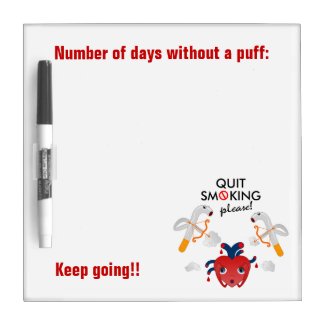Against secondhand smoke!

Quit smoking please dry erase whiteboard by noboringwhite
Check out other Quit Dry Erase Boards at zazzle.com
WORLD NO TOBACCO DAY, MAY 31
Are you celebrating it?
Smoke inhaled by smokers contains many dangerous chemicals. Secondhand smoke contains many of that same chemicals. It contains higher concentrations of many of the toxins found in cigarette smoke! The USA National Toxicology Program estimates that at least 250 chemicals in secondhand smoke are known to be toxic or carcinogenic! Secondhand smoke has been designated as a known human carcinogen (cancer-causing agent) by the U.S. Environmental Protection Agency, the National Toxicology Program, the International Agency for Research on Cancer, and an occupational carcinogen by the National Institute for Occupational Safety and Health. Why? It contains more than 50 cancer-causing chemicals! When nonsmokers are exposed to secondhand smoke, they inhale many of the same cancer-causing chemicals that smokers inhale. So, there are monsters in secondhand smoke. They will harm your health in many ways. Maybe you were not aware of it! You can't see it! I confess, I never imagine that secondhand smoke was this dangerous until I started my research on the theme!
Get to know the monsters! Check this quick list!
Poisonous gases and chemicals:
Hydrogen cyanide - it is used in chemical weapons
Carbon monoxide - it is found in car exhaust
Butane - it is used in lighter fluid
Ammonia - it is used in household cleaners
Toluene - you can find it paint thinners.
Some of the toxic metals contained in secondhand smoke:
Arsenic - it is used in pesticides
Lead - it was formerly found in paint
Chromium - it's used to make steel
Cadmium - it's used to make batteries.
There are more than 50 cancer-causing chemicals in secondhand smoke that fall into different chemical classes, including:
Polynuclear aromatic hydrocarbons (PAHs) (such as Benzo[a]pyrene)
N-Nitrosamines (such as tobacco-specific nitrosamines)
Aromatic amines (such as 4-aminobiphenyl)
Aldehydes (such as formaldehyde)
Miscellaneous organic chemicals (such as benzene and vinyl chloride) and
Inorganic compounds (such as those containing metals like arsenic, beryllium, cadmium, lead, nickel, and radioactive polonium-210).
Eleven compounds in tobacco smoke have been identified by the International Agency for Research on Cancer as Group 1 (known human carcinogen) carcinogens:
2-naphthylamine
4-aminobiphenyl
Benzene
Vinyl chloride
Ethylene oxide
Arsenic
Beryllium
Nickel compounds
Chromium
Cadmium and polonium-210.

Comments
Post a Comment
Thank you very much for visiting A Portuguese Love. Come back soon!